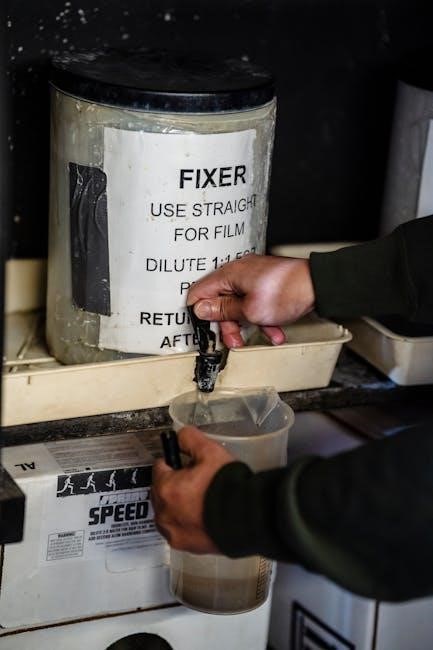Jeep TJ manual transmission fluid is essential for smooth gear operation and component protection. The recommended 75W-90 viscosity and GL-4 rating ensure optimal performance across various temperatures and conditions.

Importance of Using the Correct Fluid Type
Using the correct fluid type in your Jeep TJ manual transmission is crucial for maintaining optimal performance and preventing damage. The right fluid ensures proper lubrication, reduces wear on gears and bearings, and prevents overheating. Incorrect fluid can lead to premature component failure, gear grinding, and costly repairs. Additionally, the correct fluid type, such as 75W-90 with a GL-4 rating, is specifically designed to handle the stress of off-road driving and varying temperatures. It also helps maintain smooth shifting and protects against corrosion. Neglecting to use the appropriate fluid can void warranties and compromise the longevity of your transmission. Always refer to your owner’s manual or consult a professional to ensure compatibility and avoid potential issues. Proper fluid selection is a simple yet critical step in maintaining your Jeep TJ’s reliability and performance.

Recommended Fluid Specifications for Jeep TJ Manual Transmission
The Jeep TJ manual transmission requires fluid with a 75W-90 viscosity and GL-4 rating. This ensures proper lubrication, protects internal components, and maintains smooth gear operation across various temperatures and driving conditions.
3.1. Viscosity Requirements (75W-90)
The Jeep TJ manual transmission requires fluid with a 75W-90 viscosity rating. This viscosity grade ensures optimal performance across a wide range of temperatures, from cold starts to high operating temperatures. The “75W” designation indicates the fluid’s flow characteristics in colder conditions, while the “90” denotes its thickness at higher temperatures. This balance is critical for maintaining proper lubrication, reducing wear on internal components, and preventing overheating. Using the correct viscosity helps maintain smooth gear shifting, reduces friction, and ensures the transmission operates quietly and efficiently. It’s essential to avoid using fluids with the wrong viscosity, as this can lead to premature wear or even transmission failure. Always consult the owner’s manual or a trusted guide to confirm the correct specifications for your Jeep TJ.
3.2. GL-4 Rating and Its Significance
The GL-4 rating is a critical specification for Jeep TJ manual transmission fluid, ensuring it meets the necessary standards for gear protection and performance. This rating, defined by the American Petroleum Institute (API), indicates the fluid’s ability to protect against wear and tear on gears, synchronizers, and other internal components. GL-4 fluids are specifically designed for manual transmissions, providing superior lubrication and friction control compared to lower-rated fluids. Using a fluid with the GL-4 rating is essential to prevent premature wear, gear damage, and potential transmission failure. It also ensures smooth shifting and quiet operation. Always verify that the fluid you use carries the GL-4 certification to maintain your Jeep TJ’s transmission health and performance. Consulting your owner’s manual or a trusted source for confirmation is highly recommended.

Fluid Capacity for Jeep TJ Manual Transmission
The Jeep TJ manual transmission requires approximately 4.5 pints of fluid, with specifications calling for 75W-90 viscosity and GL-4 rating to ensure proper lubrication and protect internal components effectively.
4.1. Manual Transmission Fluid Capacity
The Jeep TJ manual transmission typically requires approximately 4.5 pints (2.25 quarts) of fluid for optimal performance. This capacity ensures proper lubrication of gears and internal components, preventing wear and tear. It’s crucial to use the correct fluid type, as specified in the owner’s manual, to maintain compatibility and avoid damage. Overfilling or underfilling can lead to operational issues, so precise measurement is essential. For reference, the manual transmission fluid capacity is designed to cover the entire system, including the gearbox and related mechanisms. Always consult the owner’s manual for precise recommendations tailored to your vehicle’s specifications and operating conditions. Proper fluid levels are vital for maintaining smooth gear transitions and ensuring the longevity of your Jeep TJ’s manual transmission system.
4.2. Transfer Case Fluid Capacity
The transfer case in a Jeep TJ typically requires approximately 2 to 4 quarts of fluid, depending on the model year and any modifications. It is essential to use the correct fluid type, often specified as ATF (Automatic Transmission Fluid) or a similar synthetic fluid designed for transfer cases. The transfer case is a critical component of the four-wheel-drive system, and proper fluid levels are vital for its operation and longevity. Overfilling or underfilling can lead to mechanical issues, so precise measurement is necessary. Always consult the owner’s manual or a reliable service manual for exact specifications tailored to your vehicle. Regular maintenance, including fluid checks, ensures the transfer case functions smoothly, especially in off-road conditions where four-wheel drive is frequently engaged. Proper fluid maintenance prevents wear and tear, ensuring reliable performance of the Jeep TJ’s four-wheel-drive system.
Why Checking Fluid Levels is Crucial
Regularly checking the fluid levels in your Jeep TJ’s manual transmission and transfer case is essential for maintaining their performance and longevity. Low fluid levels can lead to increased wear on internal components, overheating, and eventual failure. Transmission fluid degrades over time due to heat and friction, reducing its ability to lubricate and protect moving parts. If fluid levels drop below the minimum mark, it can cause gears to grind or slip, leading to costly repairs. Additionally, contamination from dirt or water can compromise fluid quality, while overfilling can create excessive pressure. Proper fluid levels ensure smooth gear engagement, optimal lubrication, and consistent performance, especially in demanding conditions like off-roading. Neglecting fluid checks can result in premature wear and failure, making regular inspections a critical part of routine maintenance for your Jeep TJ.
How to Check Manual Transmission Fluid Levels
To check the manual transmission fluid levels in your Jeep TJ, start by gathering the necessary tools: a socket wrench, a 3/8-inch socket, and paper towels for cleaning. Locate the transmission fluid drain plug, typically found at the bottom of the transmission pan. Warm up the engine by driving for a few minutes to ensure the fluid circulates evenly. Place a drain pan under the transmission and remove the plug to drain a small amount of fluid. Inspect the color and consistency—it should be clear or amber-colored and free of debris. Reinstall the plug and check the fluid level by referencing the markings on the transmission pan. If the level is low, refill with the recommended fluid type. Proper fluid levels are crucial for smooth operation, so always double-check before driving. This process ensures optimal lubrication and prevents potential damage to the transmission system.
Signs of Low or Degraded Transmission Fluid
Identifying signs of low or degraded transmission fluid is essential for maintaining your Jeep TJ’s performance. Common indicators include erratic shifting, such as hesitation or jerking between gears. You may also notice unusual noises, like grinding or whining sounds from the transmission. Slipping gears, where the vehicle doesn’t accelerate smoothly, is another red flag. Additionally, the “Check Engine” light may illuminate on the dashboard, signaling potential issues. Over time, degraded fluid can lose its lubricating properties, leading to increased friction and wear on internal components. If the fluid appears dark, murky, or has a burnt smell, it has likely degraded. Addressing these signs promptly prevents costly repairs and ensures smooth operation. Regular fluid checks and maintenance are vital to extend the life of your Jeep TJ’s manual transmission.
When to Change the Manual Transmission Fluid
Change the manual transmission fluid every 30,000 to 60,000 miles, depending on driving conditions. Severe use, like frequent towing or stop-and-go traffic, may require more frequent changes. Check the owner’s manual for specifics. If the fluid appears dark or has a burnt odor, it’s time to replace it. Additionally, if you notice symptoms like difficulty shifting gears or unusual noises, consider changing the fluid promptly to maintain optimal transmission performance and longevity.
8.1. Recommended Change Intervals
For the Jeep TJ manual transmission, the recommended fluid change interval typically ranges between 30,000 to 60,000 miles, depending on driving conditions. Under normal driving conditions, such as moderate temperatures and average mileage, changing the fluid every 50,000 to 60,000 miles is sufficient. However, for severe use, such as frequent towing, off-road driving, or extreme temperatures, the interval should be shortened to every 30,000 miles. Regular fluid changes help maintain transmission health by preventing wear and tear on internal components. Always consult the owner’s manual for precise recommendations tailored to your specific vehicle and usage patterns. Adhering to these intervals ensures optimal performance and extends the lifespan of your manual transmission. Additionally, using high-quality GL-4 rated fluid is crucial for maintaining proper lubrication and protection.
8.2. Symptoms Indicating Immediate Change
If you notice certain symptoms, it may be necessary to change the manual transmission fluid in your Jeep TJ immediately. These include slipping gears, grinding noises during shifting, or delayed acceleration. A delay in engaging gears, especially when shifting from neutral to first gear or reverse, is a common sign of low or degraded fluid. Additionally, excessive heat from the transmission or a burning smell indicates fluid breakdown. Leaks from the transmission pan or case seals also require prompt attention. If the check engine light illuminates with codes related to transmission performance, it’s crucial to inspect and change the fluid. Ignoring these symptoms can lead to premature wear or even transmission failure. Always address these issues quickly to maintain your Jeep TJ’s performance and longevity.
Steps to Change Manual Transmission Fluid
Drain the old fluid, replace the filter, and refill with new fluid meeting Jeep TJ specifications. Ensure the process is done correctly to maintain smooth transmission performance and longevity.
9.1. Tools and Materials Needed
To change the manual transmission fluid in a Jeep TJ, you’ll need a few essential tools and materials. Start with a drip pan or drain pan to catch the old fluid. A jack and jack stands are necessary to safely lift and support the vehicle. For draining, you’ll need a wrench or socket set, specifically a 3/8-inch socket for the drain plug. A screwdriver will help remove the transmission pan bolts. Replace the transmission filter with a new one, and have a funnel on hand for refilling with the correct fluid type. Keep rags and safety glasses handy for cleanup and protection. Finally, ensure you have the right amount of new transmission fluid and dispose of the used fluid responsibly.
9.2. Drain and Refill Procedure
Start by lifting the Jeep TJ using a jack and securing it with jack stands for safety. Locate the transmission drain plug, typically at the bottom of the transmission pan. Use a wrench or socket to remove the plug, allowing the old fluid to drain into a drip pan. Once drained, replace the plug and tighten it to the specified torque. Next, remove the transmission pan bolts and pull the pan down to access the filter. Replace the old filter with a new one, ensuring it’s properly seated. Reattach the pan and refill the transmission with the recommended fluid type. Use a funnel to pour in the fluid, and check the level using the dipstick or by following the manufacturer’s instructions. Finally, dispose of the used fluid responsibly and clean up any spills immediately;
Common Mistakes to Avoid During Fluid Change
When changing the manual transmission fluid in your Jeep TJ, there are several common mistakes to avoid. One of the most critical errors is using the wrong fluid type, as this can damage the transmission and void its warranty. Overfilling or underfilling the transmission is another mistake, as it can lead to improper lubrication and potential damage. Neglecting to replace the transmission filter during the fluid change is also a frequent oversight, as a dirty filter can contaminate the new fluid. Additionally, failing to tighten the drain plug properly can result in leaks. Using the wrong tools or not following the correct torque specifications can cause damage to the transmission pan or threads. Finally, disposing of the used fluid improperly is not only environmentally hazardous but also illegal in many areas. Always follow the manufacturer’s guidelines and take necessary precautions to ensure a safe and effective fluid change.
OEM Recommendations for Fluid Type
For the Jeep TJ manual transmission, the OEM (Original Equipment Manufacturer) recommends using a high-quality gear oil that meets specific standards. The factory-spec fluid is typically a 75W-90 gear oil, which is designed to provide optimal lubrication and protection for the transmission components. This fluid viscosity ensures smooth operation in both cold and hot temperatures. Additionally, the OEM specifies that the fluid must carry a GL-4 certification, which denotes its suitability for use in automotive gearboxes. Using the OEM-recommended fluid ensures compatibility with the transmission’s materials and maintains its performance characteristics. It’s important to avoid using fluids that do not meet these specifications, as they may cause premature wear or damage to the transmission. Always refer to the owner’s manual or consult with a dealership for the most accurate and up-to-date fluid recommendations.
Aftermarket Fluid Options for Jeep TJ
For Jeep TJ owners seeking alternatives to OEM fluids, several high-quality aftermarket options are available. These fluids are designed to meet or exceed OEM specifications while offering enhanced performance characteristics. Popular aftermarket brands like Amsoil, Red Line, and Royal Purple provide synthetic and high-performance gear oils that offer superior lubrication, thermal stability, and wear protection. These fluids are often formulated with advanced additives to improve viscosity index, reduce friction, and extend transmission life. Aftermarket options may also cater to specific driving conditions, such as extreme temperatures or heavy-duty off-road use. When selecting an aftermarket fluid, ensure it meets the GL-4 certification and 75W-90 viscosity requirements for compatibility with the Jeep TJ manual transmission. Always consult product specifications and reviews to choose the best option for your vehicle’s needs.
Cost of Manual Transmission Fluid Change
The cost to change the manual transmission fluid in a Jeep TJ can vary based on whether you perform the task yourself or hire a professional. If doing it yourself, the primary expense is the transmission fluid itself. High-quality 75W-90 synthetic fluids typically cost between $10 to $20 per quart, and the Jeep TJ manual transmission usually requires about 4 quarts. This brings the fluid cost to around $40 to $80. Additionally, you may need to purchase tools like a drain pan, socket set, and rags, which can add another $20 to $30 to the total cost.
If opting for professional service, labor costs will apply. Mechanics usually charge between $50 to $100 for the labor, depending on the shop and the complexity of the job. Therefore, the total cost for a professional fluid change would range from approximately $90 to $180, inclusive of both parts and labor. It’s advisable to consult specific retailers or service centers for precise pricing and to ensure the fluid meets the required specifications for your vehicle.

DIY vs. Professional Fluid Change
Deciding between a DIY fluid change and a professional service depends on your comfort level and resources. A DIY approach can save money and is relatively straightforward if you have basic tools and mechanical knowledge. It allows you to use high-quality fluids tailored to your Jeep TJ’s needs and ensures the job is done to your standards. However, it requires time, effort, and proper disposal of used fluid.
Professional fluid changes offer convenience and expertise. Mechanics have specialized tools and experience, reducing the risk of errors. They also handle fluid disposal responsibly. While more expensive, it’s a good option if you’re short on time or unsure about the process. Ultimately, choose the method that best fits your skills, budget, and preference for peace of mind.
Tips for Maintaining Transmission Health
Maintaining your Jeep TJ’s manual transmission health requires regular checks and mindful driving habits. Always ensure the fluid level is within the recommended range, as low levels can cause overheating and wear. Avoid extreme temperatures by not overloading the vehicle or driving aggressively, as this can degrade the fluid faster. Keep your driving consistent, especially in stop-and-go traffic, to prevent excessive heat buildup. Regularly inspect the transmission pan and lines for leaks, addressing them promptly to prevent fluid loss. Use only high-quality filters during fluid changes to maintain cleanliness. Finally, avoid towing heavy loads beyond the vehicle’s capacity, as this can strain the transmission. By following these tips, you can extend the lifespan of your transmission and ensure smooth operation for years to come.

Role of Transmission Fluid in Vehicle Performance
Transmission fluid plays a vital role in ensuring the optimal performance of your Jeep TJ’s manual transmission. It acts as a lubricant, reducing friction between moving components like gears and bearings to prevent wear and tear. Additionally, it serves as a coolant, dissipating heat generated during operation to prevent overheating. The fluid also enables smooth gear engagement and disengagement, ensuring precise shifting and consistent power delivery. By maintaining the right viscosity and GL-4 rating, the fluid protects against corrosion and extends the lifespan of transmission components. Proper fluid levels and quality are essential for maintaining vehicle performance, especially during off-roading or hauling heavy loads. Without adequate transmission fluid, the system can overheat, leading to premature wear and potential failure, which can result in costly repairs and reduced vehicle reliability.

Compatibility of Transmission Fluid with Other Components
Ensuring the compatibility of transmission fluid with other components in your Jeep TJ is critical for maintaining system integrity. The fluid must be compatible with the materials used in the transmission, such as seals, gaskets, and metal components. Using the wrong type of fluid can lead to premature wear, corrosion, or damage to these parts. For example, some transmission fluids may not be compatible with synthetic rubber seals or brass components, potentially causing leaks or failure. Additionally, the fluid’s additive package must align with the transmission’s design to prevent chemical reactions that could degrade components. Always verify compatibility with your Jeep TJ’s specific materials and components before introducing new fluid. This ensures optimal performance and longevity of the transmission system, avoiding costly repairs down the line.
Storage and Handling of Transmission Fluid
Proper storage and handling of transmission fluid for your Jeep TJ are essential to maintain its quality and performance. Always store the fluid in a clean, cool, and dry place, away from direct sunlight and heat sources. The container should be tightly sealed to prevent contamination from dust, moisture, or debris. Use the original container if possible, as it is designed to preserve the fluid’s properties. When handling, avoid exposing the fluid to extreme temperatures or physical stress, as this can degrade its viscosity and additive package. Before use, inspect the fluid for any visible signs of contamination or damage to the container. Proper handling ensures the fluid remains effective and safe for use in your Jeep TJ’s manual transmission system, preventing potential damage or performance issues.

Environmental Considerations for Fluid Disposal
Disposing of Jeep TJ manual transmission fluid requires careful consideration to minimize environmental impact. Transmission fluid contains hazardous chemicals that can harm the environment if not disposed of properly. Never pour used fluid down drains, sewers, or onto the ground, as it can contaminate waterways and soil. Instead, take the fluid to a certified hazardous waste collection facility or an auto repair shop that accepts used fluids. Many communities offer household hazardous waste collection events. Always store used fluid in a sealed, leak-proof container to prevent spills during transport. Check local regulations for specific guidelines on fluid disposal. Proper disposal ensures the protection of ecosystems and compliance with environmental laws. Recycling options may also be available for used transmission fluid, making it a responsible choice for maintaining both your vehicle and the planet.

Troubleshooting Transmission Issues Related to Fluid
Troubleshooting transmission issues related to fluid in a Jeep TJ involves identifying symptoms like slippage, erratic shifting, or unusual noises. Low fluid levels or contamination are common causes. Start by checking for leaks around the pan gasket, seals, or lines. If the fluid level is low, refill with the correct type and specification. Old or degraded fluid may cause poor performance, so consider a fluid change. Using the wrong fluid type can lead to compatibility issues, such as clutch pack failure or premature wear. If problems persist, inspect the filter and clean or replace it as needed. Refer to the owner’s manual for guidance. Addressing these issues early can prevent costly repairs and ensure smooth transmission operation. Always consult a professional if DIY troubleshooting doesn’t resolve the problem.
Fluid Requirements for Modified or High-Performance Jeep TJ
For modified or high-performance Jeep TJ models, transmission fluid requirements may differ due to increased stress on the drivetrain. High-performance driving conditions, such as racing or off-road adventures, demand fluids with enhanced thermal stability and lubrication properties. A higher viscosity grade, such as 75W-140, is often recommended to handle excessive heat and torque. Additionally, synthetic transmission fluids are preferred for their superior performance in extreme temperatures and durability under heavy loads. It’s crucial to ensure the fluid meets or exceeds the GL-4 rating while also being compatible with the transmission’s components. Modified Jeeps may also require higher fluid capacity due to aftermarket upgrades like larger transmission pans or auxiliary coolers. Always consult the manufacturer’s specifications or a qualified mechanic to determine the best fluid for your modified TJ to maintain optimal performance and prevent premature wear.

Regional Variations in Fluid Recommendations
Regional variations in climate and driving conditions can influence the recommended transmission fluid for Jeep TJ models. In colder climates, a lower viscosity fluid like 75W-90 is often preferred to ensure smooth shifting and easier cold-weather startups. In hotter regions, higher viscosity fluids may be recommended to maintain lubrication and prevent overheating. Additionally, extreme humidity or dust-prone areas might require more frequent fluid changes or specialized additives to protect against contamination. High-altitude driving may also necessitate fluids with specific properties to handle the unique stress on the transmission. Always consider local environmental factors and consult with regional experts or dealerships to ensure the fluid choice aligns with your specific operating conditions. This tailored approach helps maximize transmission performance and longevity in diverse environments.
Fluid Change Frequency Based on Usage
The frequency of changing manual transmission fluid in a Jeep TJ depends on usage conditions. For normal driving, the fluid should be replaced every 30,000 to 60,000 miles. However, if the vehicle is subjected to extreme conditions such as frequent towing, hauling heavy loads, or off-road adventures, the fluid should be changed more often, typically every 15,000 to 30,000 miles. Severe driving habits, like rapid acceleration or driving in extremely hot or cold climates, also warrant more frequent changes. It’s crucial to monitor the fluid’s condition and adjust the change interval accordingly. Always consult the owner’s manual or a qualified mechanic for personalized recommendations based on your specific usage patterns to ensure optimal transmission performance and longevity.
Proper maintenance of the Jeep TJ’s manual transmission is essential for ensuring its longevity and performance. Regular fluid checks, timely changes, and using the correct fluid type are critical to preventing damage and maintaining smooth operation. Always adhere to the recommended fluid specifications and change intervals based on usage conditions. Avoid over-tightening drain plugs and ensure the vehicle is on level ground during fluid checks. Keep track of maintenance records to stay organized and proactive. By following these guidelines and remaining vigilant about transmission health, Jeep TJ owners can enjoy reliable performance for years to come. Remember, a well-maintained transmission is the backbone of a smooth and enjoyable driving experience.

